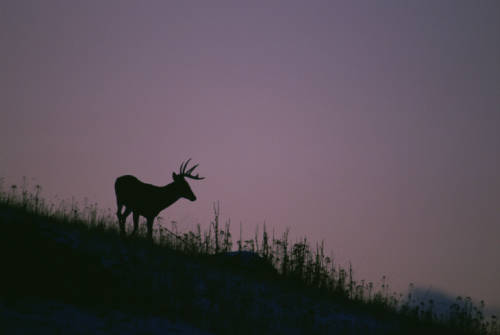October 16, 2019

The silhouette of a White-tailed Deer standing on a hillside stands out against a purple sky at dusk. (USFWS)
As the states’ human population increases, and more people move to the country increasing commuting traffic, so does deer-vehicle collisions.
Drivers throughout the state should be cautious of roaming white-tailed deer throughout the year, especially during the rut or breeding season, typically from October to November. Studies show that about 45% of deer-vehicle collisions occur during this time as deer naturally increase their movements related to breeding.
Most vehicle collisions occur near dawn and dusk because deer tend to move more during these times. Unfortunately, these are also the times that most humans commute to work in their vehicles.
Although deer-vehicle collisions are an issue in South Carolina, the state is in a much better position than most states, particularly states in the Northeast and upper Midwest where there are a reported 30,000-50,000 deer-vehicle collisions annually.
The S.C. Department of Public Safety reported approximately 2,900 reported deer-vehicle collisions in 2018, similar to the year prior.
Sound deer management through regulated annual harvest is the most effective way of curtailing deer-vehicle collisions but following some commonsense rules for driving defensively in deer country will make the trip safer.
- White-tailed deer are masters at evading predators; however, these same predator-avoidance instincts often cause deer to bolt in front of oncoming vehicles.
- When deer are sighted well ahead of the vehicle sounding the horn several times, flicking headlights (if no oncoming traffic is present) and reducing the vehicle’s speed.
- If deer are sighted only a short distance in front of the vehicle, these same collision-avoidance techniques - horn and flicking lights - may spook the deer into running across the road, so in that case it’s best to just slow down.
- Always anticipate another deer if you see one or more crossing the highway and do not expect the deer to get out of the way.
- Most serious injuries occur when the motorist loses control of the vehicle in an effort to avoid a deer and hits an immovable object, like a tree or embankment. If a collision with a deer is imminent, it is best to hit the deer rather than risk losing control of the vehicle.
- Motorists should understand that deer-crossing signs mark a stretch of road where deer have been hit previously, however, these signs do not mark specific deer trails. Deer may frequently cross for several miles where the signs are posted.
- Pay attention to changes in habitat types along the highway. The zone between habitat types is a likely place for deer to cross a road. Creek bottoms and where agricultural fields meet woodlands are also prime areas for deer to cross roadways.
- Rural or secondary roads rank highest in deer-vehicle accidents because of the frequent curves and narrow shoulders.
South Carolina’s deer population peaked in the late 1990’s, as did the number of deer-vehicle collisions. Since the year 2000, however, the estimated statewide deer population has decreased approximately 30% with the decline believed to be a combination of changes in habitat, high antlerless deer harvests and coyote predation on deer fawns.
What should motorists do if they hit a deer? Report the incident to the S.C. Highway Patrol or local law enforcement and to your insurance company.
Drivers can keep deer for consumption as long as there is an incident report demonstrating that the deer was killed by a vehicle and not illegally shot.
The S.C. Department of Natural Resources nor any other state agency will compensate motorists for injuries or damages resulting from deer collisions.



